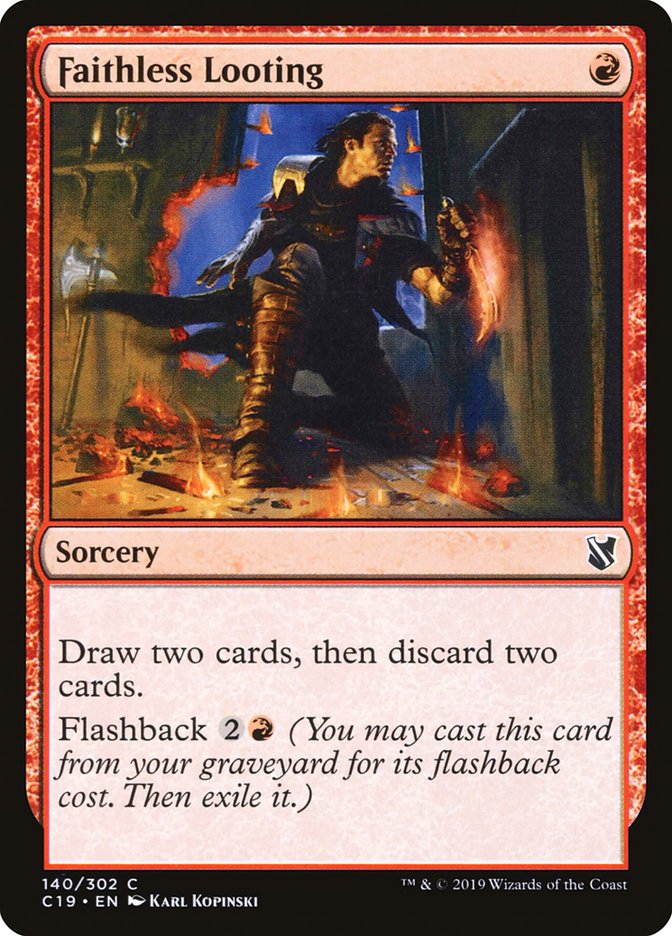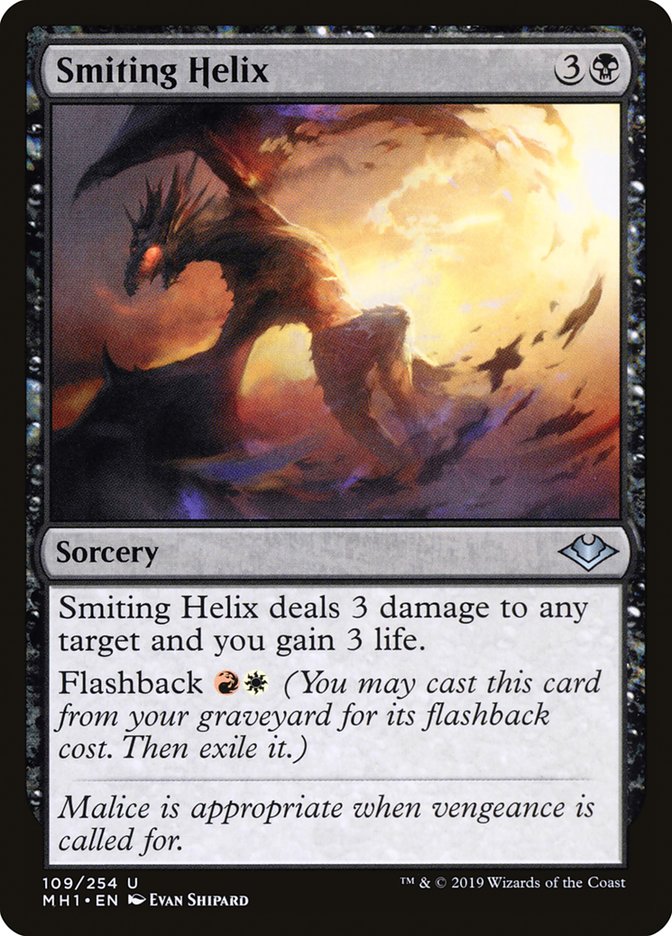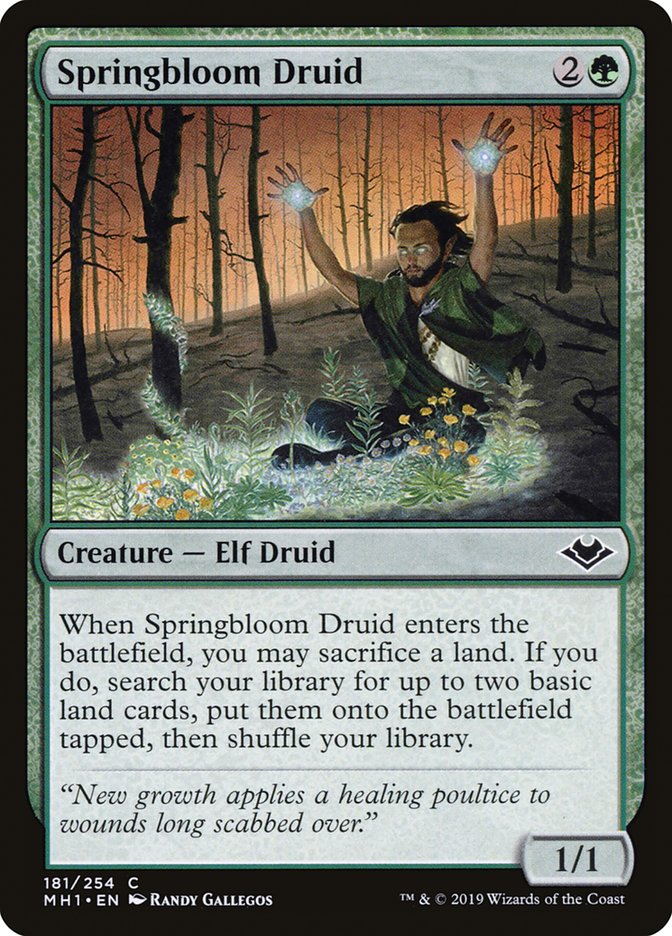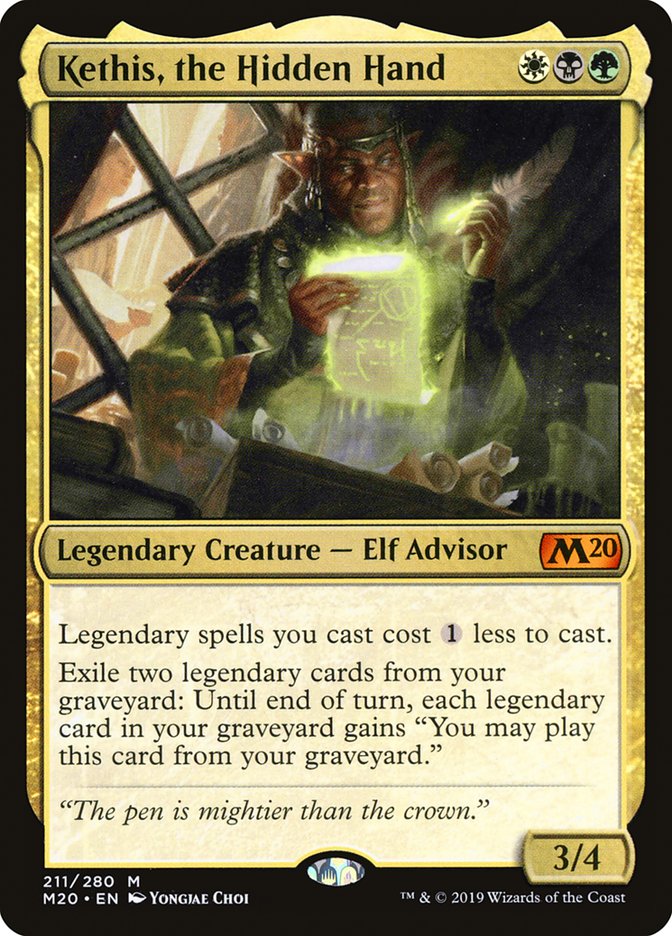Modern has always had an extremely deep bench of playable cards that just barely don’t make it. They’re a little too weak, the support isn’t quite there, or, more to the point, the best things in Modern are just so good. Before Faithless Looting’s ban, Modern was in a place where if you weren’t playing a least one of the five best cards, it was hard to justify showing up.
For the first time in a long time, Modern feels open. This feeling is likely an illusion – things will settle and we’ll know what the best strategies are. But as someone who always wishes Modern were such that we could play cards that were just a little bit weaker, like old Standard all-stars, it’s nice to be able to imagine what might be as the format feels new and open.
Part of what’s going on is that we didn’t just lose Faithless Looting. Modern Horizons offers enough hate that Ancient Stirrings and Mox Opal, two other cards that felt much better than everything else currently, both feel like they’re merely strong cards. I frequently say that I think Faithless Looting is a stronger card that Brainstorm, but that kind of undersells it.
I actually don’t think it’s close.
Brainstorm gives you card selection, but Faithless Looting gives you card selection plus numerical card advantage and free mana. Faithless Looting is like Manamorphose with Pyromancer Ascension – the kind of card that feels like wishing for more wishes, where it generates both card and mana advantage.
Removing a card draw spell from a format shouldn’t slow the format down. If people are wasting less mana sculpting their hand, that leaves more mana to play to the battlefield and try to end the game (ignoring powerful selection’s utility in setting up fast, game-ending combos), but Faithless Looting’s role in Modern wasn’t to provide card selection or card advantage; its primary purpose was to act as a Rite of Flame, letting decks get free mana value out of cards in their graveyard. Nerfing Mox Opal and banning Faithless Looting fundamentally changes the way that mana works in Modern.
Players have to actually cast their spells now, and that opens the format up to a wide range of cards people played years ago that just couldn’t stand up to the free creatures created by Arclight Phoenix, Hollow One, Bloodghast, Prized Amalgam, Hogaak, Arisen Necropolis, Vengevine, etc.
The Top 8 of the SCG Dallas Modern Open included three Burn decks, Rakdos Midrange, and Grixis Death’s Shadow, and suddenly Kitchen Finks looks like a reasonable card to consider playing in a Jund deck that’s just using it to gain life and get in combat without an infinite combo in sight, and I’m kind of excited about that level of fair Magic in Modern.
So today I want to indulge myself by looking at the cards I want to play, why I’m excited about them, and what might hold them back.
Smiting Helix
This card was certainly designed to work with Faithless Looting, but without that it’s still good with Liliana of the Veil, Seasoned Pyromancer, and milling yourself. As a fan of Lingering Souls, I was excited by this card when I first saw it in Modern Horizons, but it was overshadowed by Hogaak, Arisen Necropolis. Without Faithless Looting it might never get its moment, but I still want to try.
Creatures (11)
Planeswalkers (4)
Lands (24)
Spells (21)

This deck is kind of a mashup of John Lim’s Rakdos Midrange and Jacob Hagen’s Orzhov Smallpox. It’s possible that either of those strategies is a more focused, better way to play this kind of game, but those decks also offer proof of concept that a deck in this ballpark can compete in Modern, which is good to see. For the most part, this deck is pretty straightforward, but I want to call specific attention to the exact feeling a burn opponent would experience when you discard Smiting Helix to cast Collective Brutality against them in Game 1.
Springbloom Druid
Springbloom Druid is hard to make work in Modern. Specifically, it’s just hard to get enough basic lands in your deck that you won’t run out of lands to search for if you draw multiple Springbloom Druids, so I keep finding myself wanting to play more than 60 cards so I can get a few more lands to work with in order to have both enough basics to find and enough multicolor lands that I can actually cast my spells. That’s not off the table for me, but I know it’s a hard sell for most, so I’ll start by looking for ways to use Springbloom Druid with only 60 cards.
So why am I into Springbloom Druid? I like its interaction with the following cards in particular: Neoform, Primeval Titan, Field of the Dead, Flagstones of Trokair, and Tireless Tracker. Can I get all those cards in the same deck? Probably not, but it’d be pretty sweet if I could, so let’s see how it would look:
Creatures (26)
- 1 Eternal Witness
- 1 Reveillark
- 1 Glen Elendra Archmage
- 4 Noble Hierarch
- 3 Stoneforge Mystic
- 4 Primeval Titan
- 1 Restoration Angel
- 1 Thragtusk
- 1 Tireless Tracker
- 1 Knight of Autumn
- 4 Ice-Fang Coatl
- 4 Springbloom Druid
Planeswalkers (2)
Lands (24)
Spells (8)

This deck is ambitious and a little light on interaction, but with Primeval Titan functioning as “super Grave Titan” by fetching two copies of Field of the Dead, this deck is really looking to end games quickly despite all the early nonsense. I think of the cheap creatures in this deck as a distraction, a form of sleight of hand to get your opponent to focus on your small game while you prepare to go way over the top with a Primeval Titan. I’m also pretty excited about the idea of using Neoform to turn Springbloom Druid into Glen Elendra Archmage.
Jace, Vryn’s Prodigy
Stoneforge Mystic makes me want to play Kolaghan’s Command, and Kolaghan’s Command makes me want to play Jace, Vryn’s Prodigy. That feels a little stupid, because Jace, Vryn’s Prodigy doesn’t really want to play against Kolaghan’s Command, but I don’t think that many people are going to settle on Kolaghan’s Command specifically as their way to answer artifacts, and they’re just so good together.
Jace has already seen success in Grixis Death’s Shadow, as Ari went over earlier this week. I’m also interested in it in a Corey Burkhart-style Grixis Control deck, but for now, I want to look a little more outside the box:
Creatures (10)
Lands (22)
Spells (28)

I wanted to add lifegain to Grixis Control to improve the Burn matchup, and Pulse of Murasa plays really well here. Once I’m trying to play four colors, Arcum’s Astrolabe makes that much easier and Ice-Fang Coatl offers a quick value engine with Kolaghan’s Command. I actually wanted to splash Ojutai’s Command as well, but I figured Pulse of Murasa and Cryptic Command covered everything I needed without dipping into another color.
Kethis, the Hidden Hand
Kethis has earned its place in Core Set 2020 Standard as a combo enabler, and that combo can get even more powerful in Modern with the addition of Mox Opal as four more Mox Ambers, but I think the combo is a little clunky and easy to attack in Modern, so I’m actually interested in Kethis as a value card.
Creatures (8)
Planeswalkers (10)
- 1 Ashiok, Nightmare Weaver
- 1 Nissa, Vital Force
- 1 Liliana, Death's Majesty
- 1 Teferi, Hero of Dominaria
- 1 Vraska, Golgari Queen
- 1 Kaya, Orzhov Usurper
- 1 Teferi, Time Raveler
- 3 Tamiyo, Collector of Tales
Lands (23)
Spells (19)

This is another deck with a very heavy recursion theme, with Kethis, the Hidden Hand; Jace, Vryn’s Prodigy; Tamiyo, Collector of Tales; and Nissa, Vital Force all allowing you to reuse your cards. With Jace and Tamiyo giving you access to more Path to Exiles and Assassin’s Trophies, you should quickly be able to run your opponent out of basic lands, giving you access to a lot of fantastic removal spells, and this deck is designed to take full advantage of Kethis’s cost reduction and synergy with Oath of Nissa.
The common themes that I’m noticing with these decks are that I want to play a lot of colors and take advantage of the expectation that I can access the graveyard as a source of value, rather than as a degenerate way to cheat creatures onto the battlefield for free. All of these decks play the kind of fair game that can beat graveyard hate, but would certainly prefer not to play against it, and the way things look after the first week is that there hasn’t been much graveyard hate. While the threat of Dredge has made itself known, there are so many other things you have to prepare for that you don’t really want to go too far out of your way to beat Dredge, so I think now is a great time to try to use the graveyard to get an edge in fair mirrors.
As to playing too many colors, I suspect that’s closer to the “this would be fun” end of things than genuinely believing that it’s the most competitive way to build decks, but there is definitely something to be gained from the great mana that’s available in the format.






